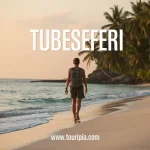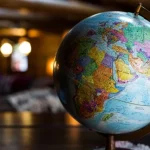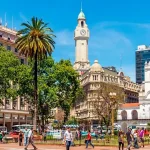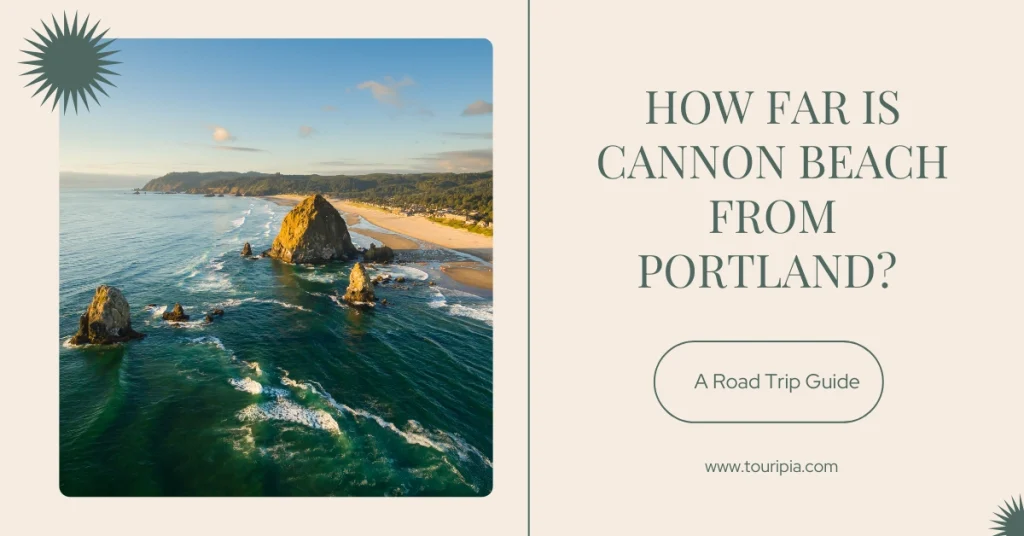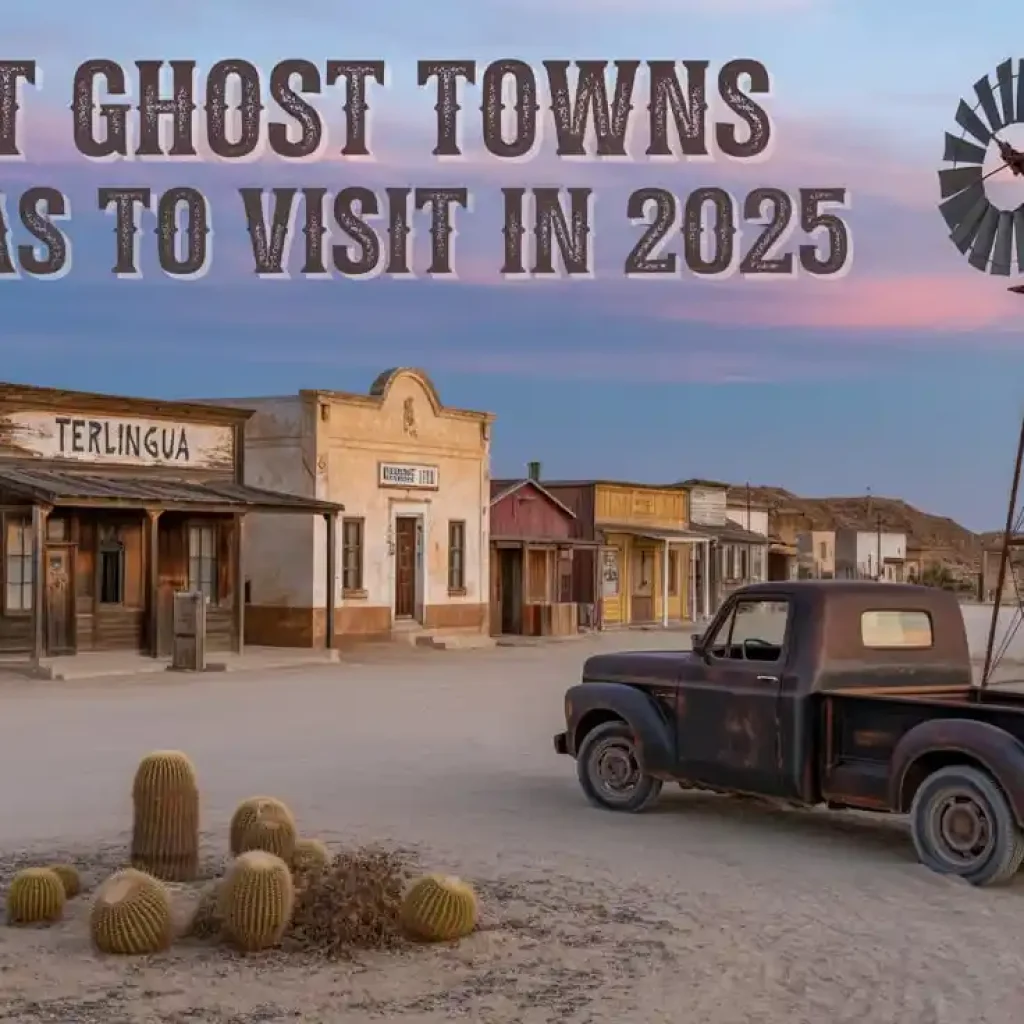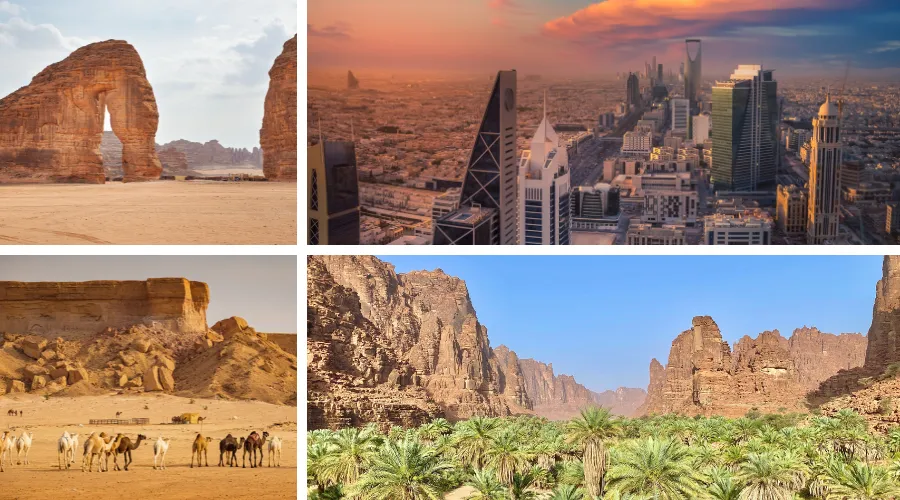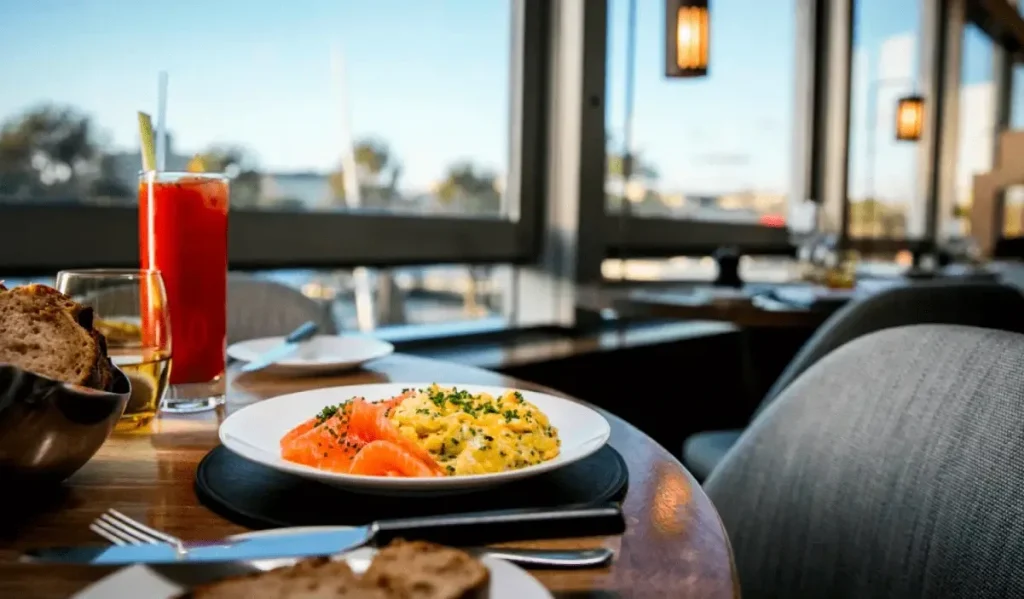15 Best Places to Hike in the Caribbean That Locals Recommend
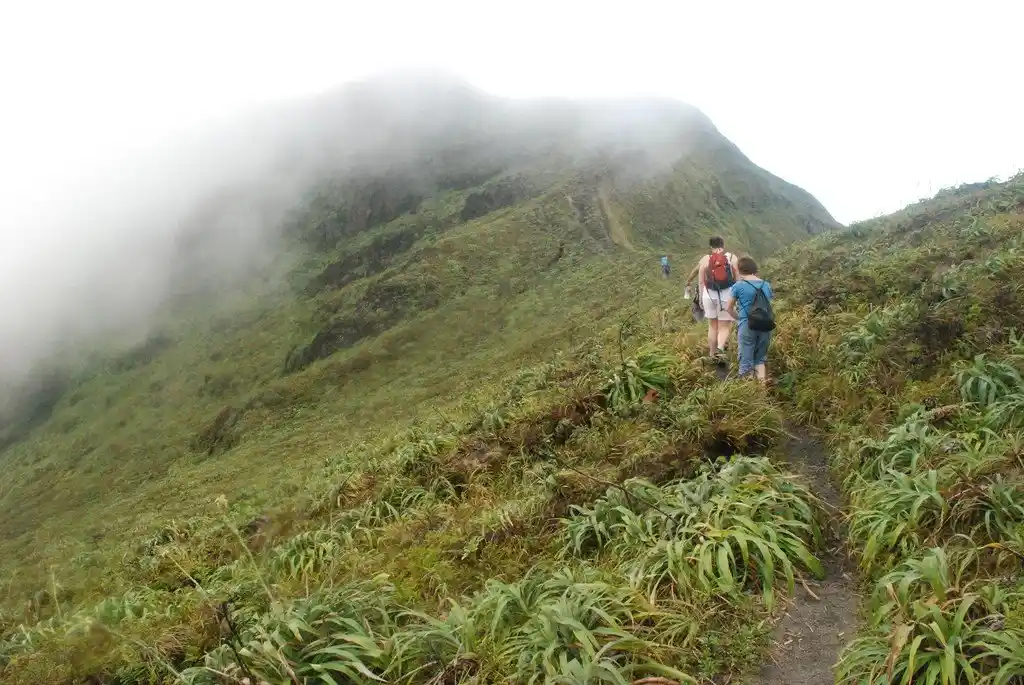
When most travelers picture the Caribbean, their minds drift toward turquoise waves and sandy resorts. But for those who live here, the best places to hike in the Caribbean reveal a deeper side of the islands—steaming volcanic craters, lush cloud forests, and trails that carry centuries of history.
Ask a local, and they’ll tell you these hikes are not just pastimes but windows into culture, ecology, and identity.
Over the years, I’ve learned that islanders see their mountains and forests as living archives. In Dominica, guides share legends about spirits guarding the rainforest; in Saint Lucia, families still climb the Gros Piton during festivals as a rite of heritage. Hiking here isn’t an alternative to the beach—it’s a parallel tradition.
Read This First: How to Hike the Caribbean Safely
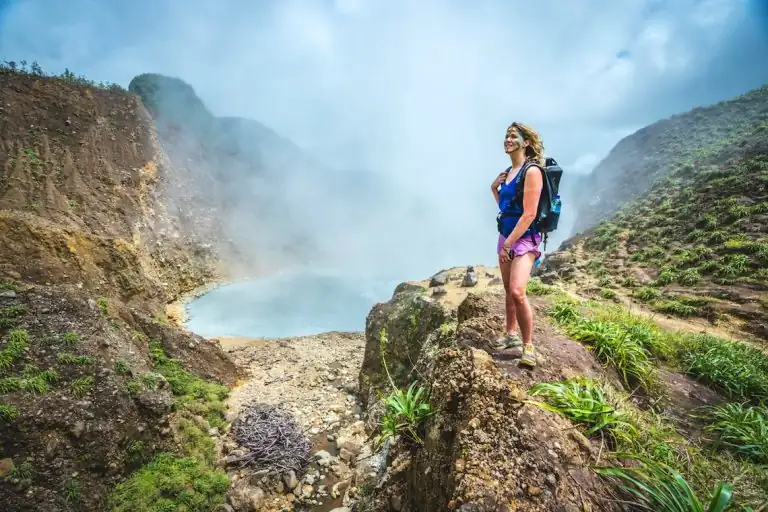
Before chasing summits, you need to respect the environment that makes hiking here both thrilling and demanding. The tropics combine heat, humidity, and sudden storms—conditions that catch unprepared travelers off guard.
Here are a few essentials:
- Hydration: Carry at least two liters of water per person; electrolyte tabs go a long way.
- Gear: Lightweight clothing, sturdy boots, and a reliable map (or better, the AllTrails app) keep you oriented.
- Navigation: A GPS receiver is invaluable on trails that split into unmarked paths.
Safety also means planning around nature’s patterns. The rainy season (typically May–November) brings slippery terrain and swollen rivers, while the hurricane season demands constant weather checks. Some hikes are best left to cooler mornings, before the sun pushes temperatures past comfort.
Local wisdom matters here. In Dominica, I was once advised not to hike after heavy rains because flash floods had swept through the same valley two weeks earlier.
In Jamaica’s Blue Mountains, a farmer reminded me to always check for venomous snakes hidden in tall grass. And across several national parks, hiring a licensed guide isn’t just about safety—it supports local livelihoods and deepens your understanding of the trail.
A note: Travel conditions can shift quickly. Park fees change, permits may be required, and trails occasionally close. Always confirm details with local tourism offices before heading out.
The 15 Best Places To Hike in the Caribbean
In this guide, we’ll explore 15 hikes across different Caribbean islands, from Dominica’s steamy Boiling Lake to Puerto Rico’s El Yunque peaks.
You’ll find trails ranging from beginner-friendly strolls to demanding ascents that test your stamina. More importantly, each comes with insights drawn directly from local hikers, guides, and my own journeys across these landscapes.
1. Dominica
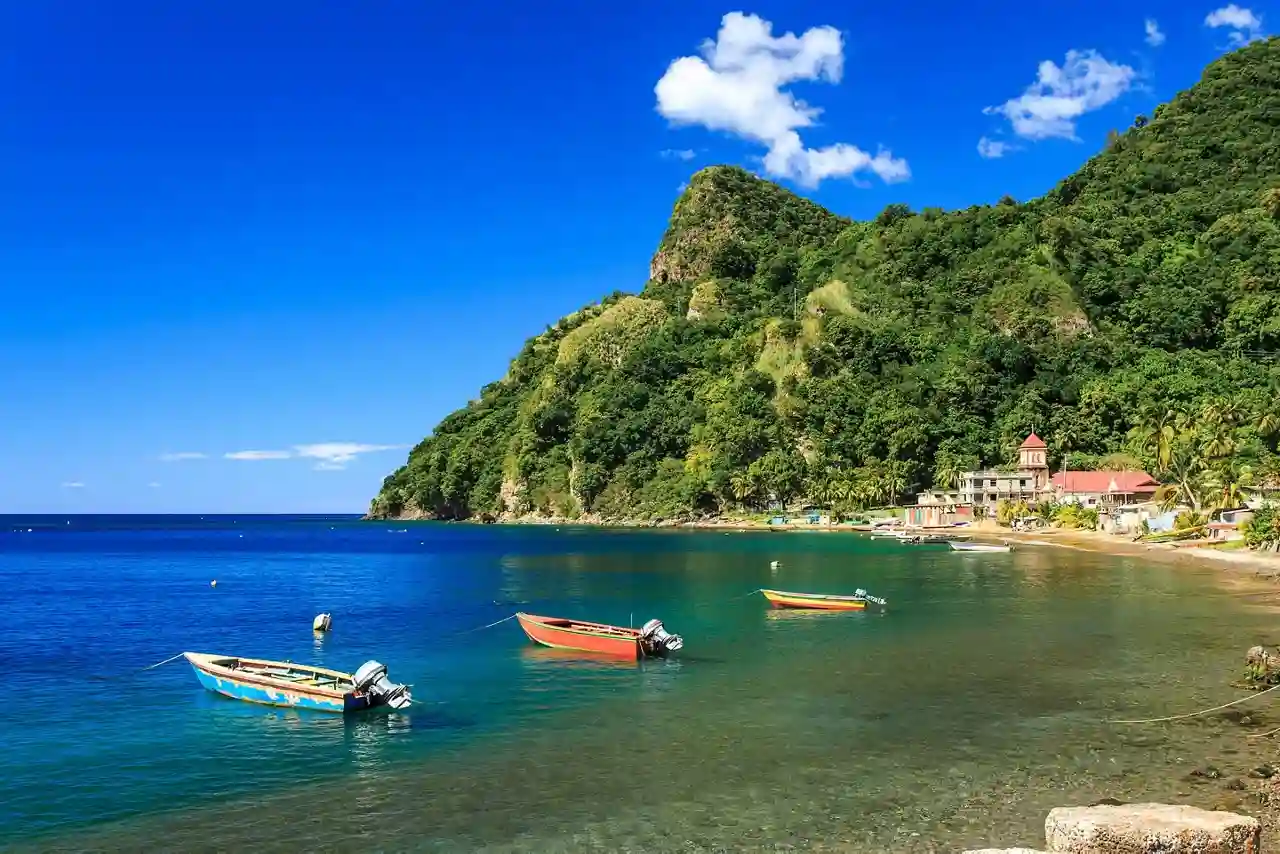
✔️ Boiling Lake
This is the Caribbean at its wildest: a steaming, gray-blue volcanic lake tucked inside Morne Trois Pitons National Park, itself a UNESCO World Heritage Site. The six-hour round trip is strenuous, climbing past sulfur vents and through dense rainforest.
I remember my first time here—crossing wooden planks slick from mist, feeling the heat radiating from the ground itself. By the time you reach the rim, staring into the second-largest boiling lake on Earth, the effort feels like a pilgrimage.
✔️ Waitukubuli National Trail
Stretching 115 miles, this trail is the Caribbean’s longest, but even short sections reveal Dominica’s essence. I hiked a portion near Layou, where old plantations give way to river crossings and villages where Creole is still spoken daily. Known locally as the Waitukubuli Trail—meaning “tall is her body”—it’s a reminder that hiking here is about culture as much as scenery.
2. Saint Lucia
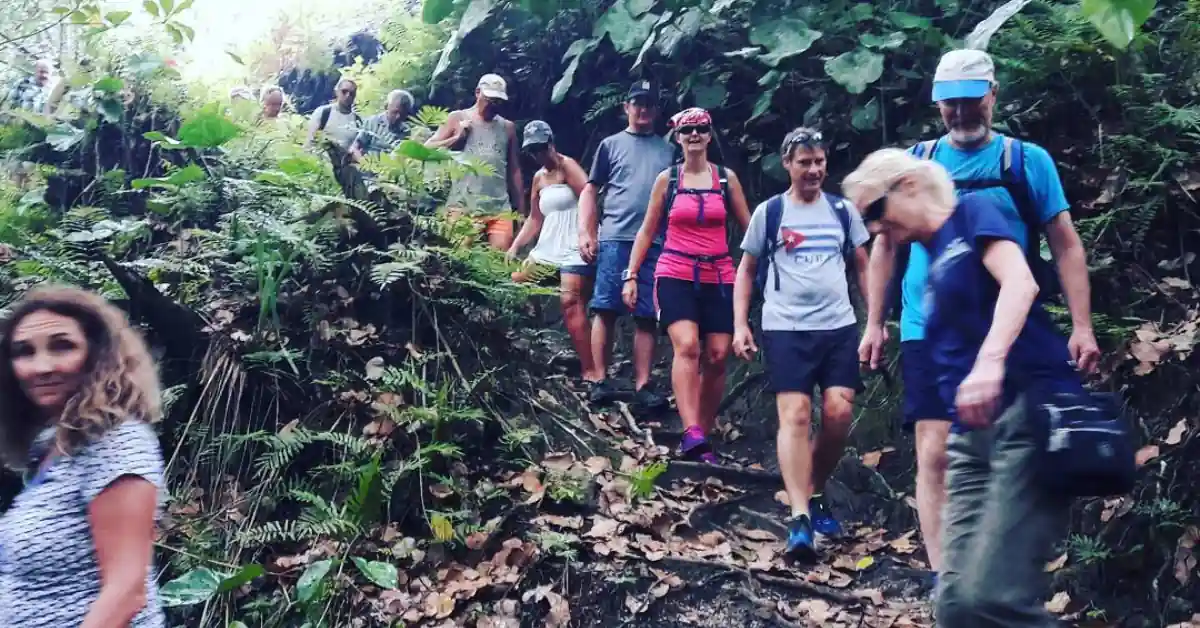
✔️ Gros Piton
The Gros Piton Hike is a bucket-list climb. Rising 2,618 feet above the Caribbean Sea, it’s steep but manageable with a guide.
Along the way, you pass the legendary Piton Mitan, a ridge where locals once sheltered during colonial conflicts. At the summit, the view stretches across the Piton mountains, with Petit Piton standing like a mirror sibling.
✔️ Tet Paul Nature Trail
For those who want breathtaking scenery without a grueling climb, Tet Paul is perfect. Just under an hour, this guided walk offers sweeping views of the Pitons and clear days when you can spot Martinique.
Local farmers along the path explain traditional cassava processing, adding cultural flavor to a short but memorable trek.
3. St Kitts & Nevis
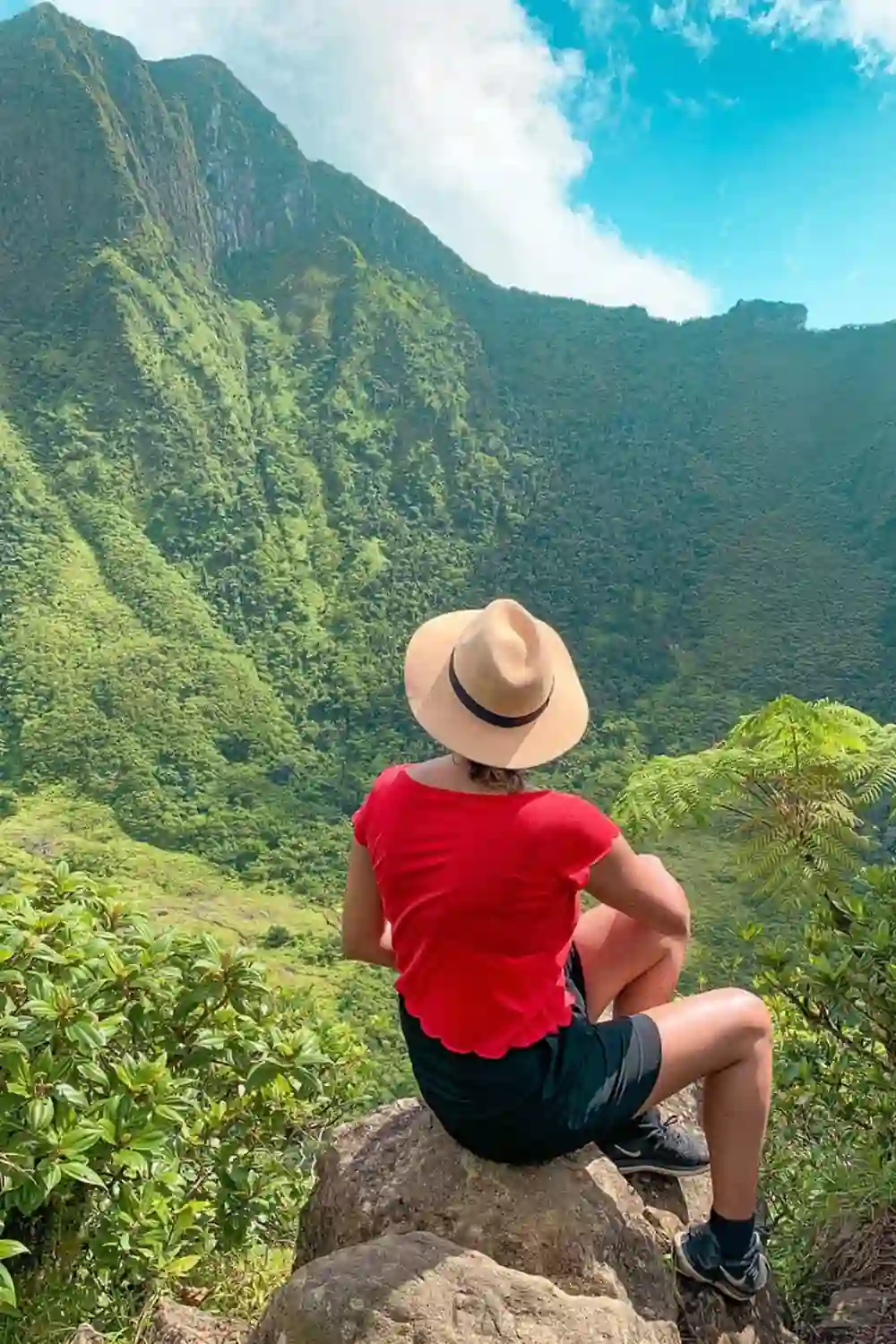
✔️ Mount Liamuiga
On St Kitts, the climb to Mount Liamuiga’s crater is one of those hikes that defines the island’s spirit. At just over 3,700 feet, it rises above sugarcane fields and into a thick rainforest that locals call the island’s “green heart.”
The path narrows until you’re looking into a vast crater lined with moss and vines, a reminder that this dormant volcano once shaped everything around it.
Standing there, mist curling through the trees, I understood why islanders say this view connects them to both land and sea.
✔️ Nevis Peak
Across the channel, Nevis Peak is steeper, muddier, and frankly more intimidating. You’ll often use ropes to pull yourself through the slick trail, especially near the upper sections.
But the effort is worth it—the summit offers 360-degree views across the Leeward Island chain. Local guides insist on pacing yourself and not rushing; I followed their advice and discovered the real reward wasn’t just the view but the camaraderie of climbing alongside others.
4. Saba
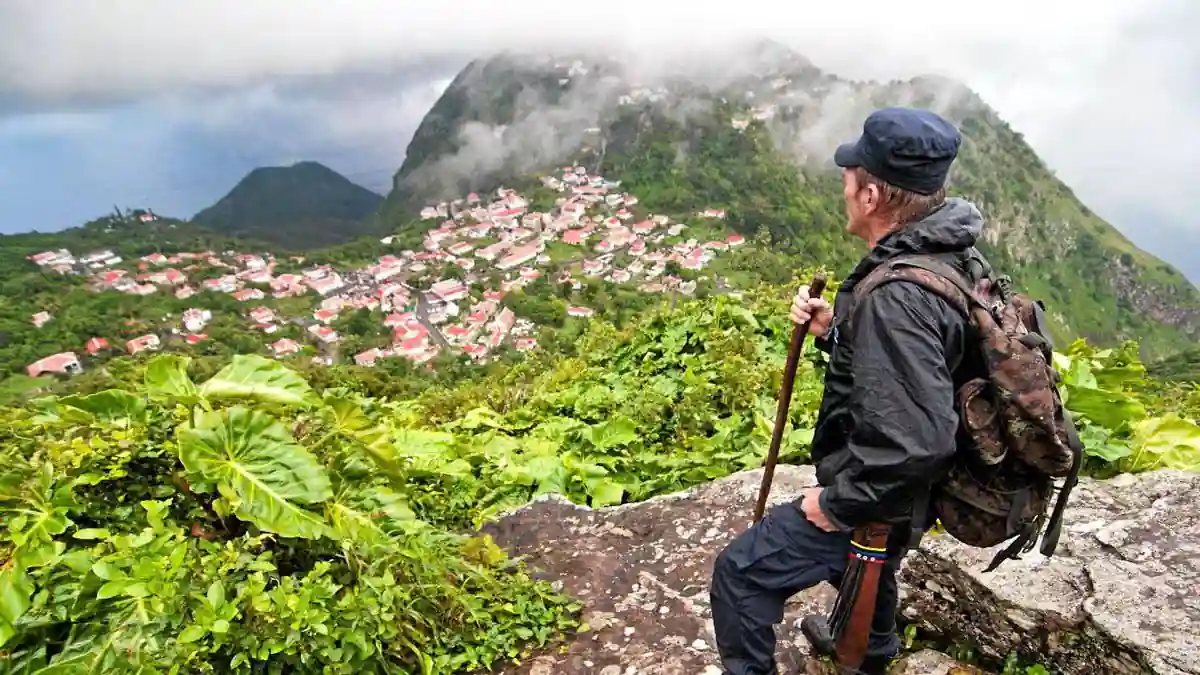
✔️ Mount Scenery
Saba may be tiny, but it holds the Caribbean’s highest point: Mount Scenery. The trail begins with stone steps in the town of Windwardside, winding through banana trees and orchids into a mist forest.
I remember pausing at the summit platform, clouds drifting below me, the world softened into silence. The islanders treat this peak with pride—after all, it’s a reminder that even the smallest Caribbean islands can rise above their reputation.
Hike here on a clear day and you’ll see as far as St Eustatius and St Kitts. On misty mornings, it feels like stepping into another realm.
5. St Vincent
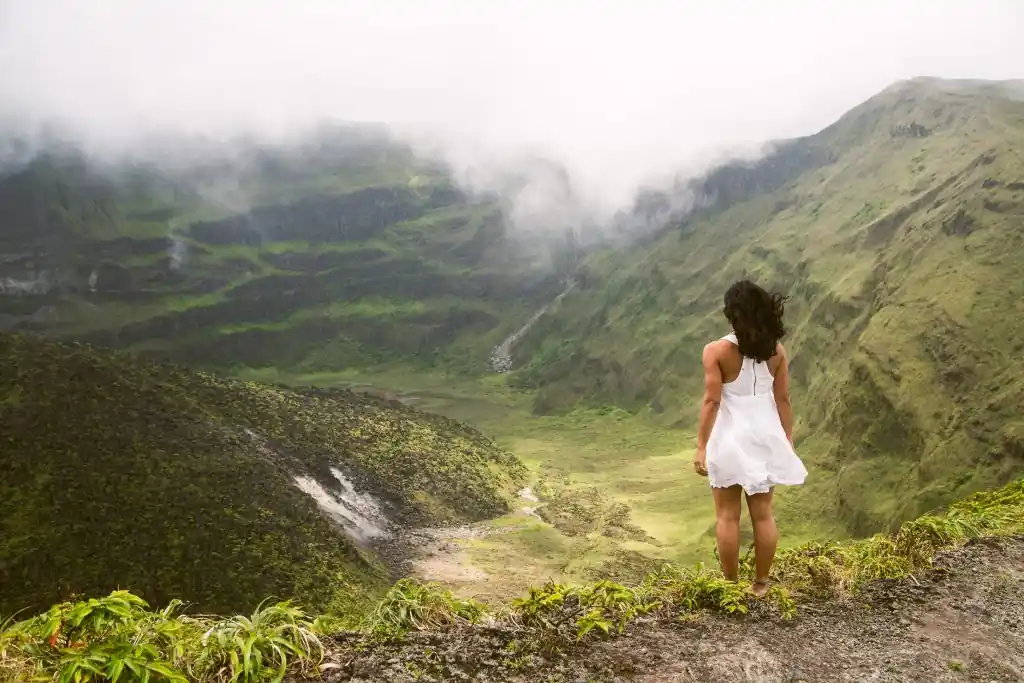
✔️ La Soufrière Volcano
Few hikes balance drama and danger like La Soufrière. This active volcano erupted as recently as 2021, and its slopes are a living geology lesson. The Mount Pelee Trail in Martinique gets more international fame, but locals argue Soufrière’s raw power is unmatched.
I set out from the Rabacca trailhead, where ash still coats the soil, and climbed through shifting vegetation zones until the crater rim came into view. From up top, you see smoke rising from vents and the vast volcanic craters etched into the landscape.
The trail is challenging but deeply humbling. Villagers along the base still tell stories of the devastation from past eruptions. For me, hiking here wasn’t just about landscapes—it was about respecting how communities live with, and adapt to, a volatile environment.
6. Grenada
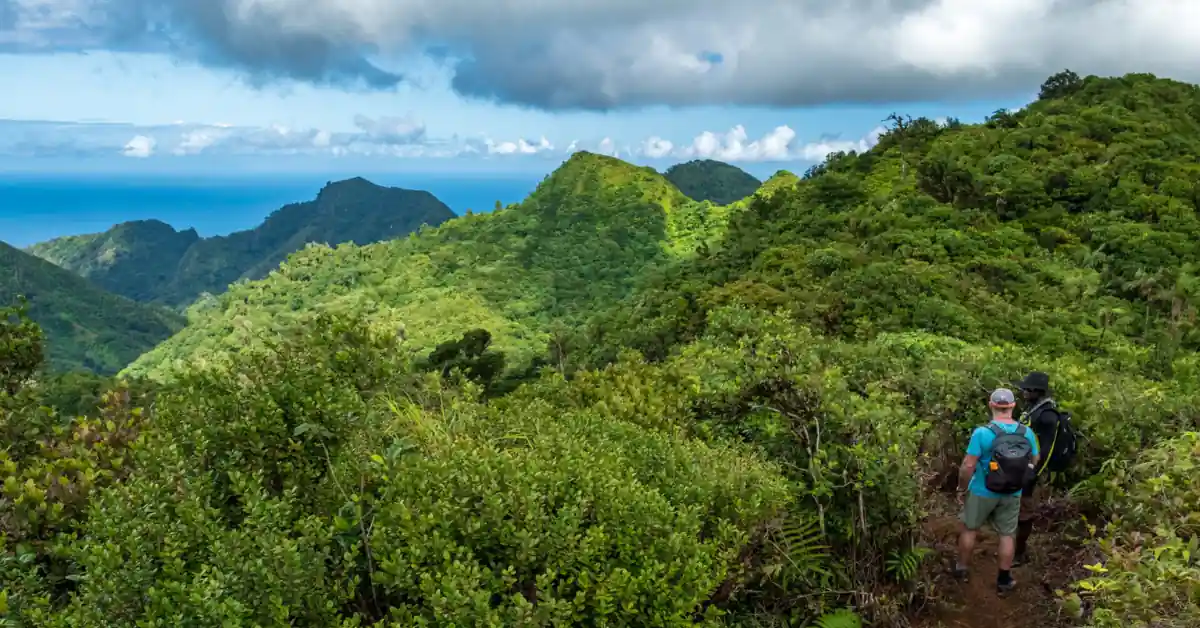
✔️ Seven Sisters Falls
Grenada isn’t just spice plantations and beaches—its interior hides some of the most refreshing rainforest trails in the region. The hike to Seven Sisters Falls is moderate, weaving past nutmeg trees and small farming plots before descending to a series of pools.
I remember slipping off my boots and diving into the cool water, with local kids already cliff-jumping nearby. It’s a place where hiking blends seamlessly with daily island life. Bring a guide if you’re unfamiliar with the terrain, since the paths can get muddy during the rainy season.
7. Puerto Rico
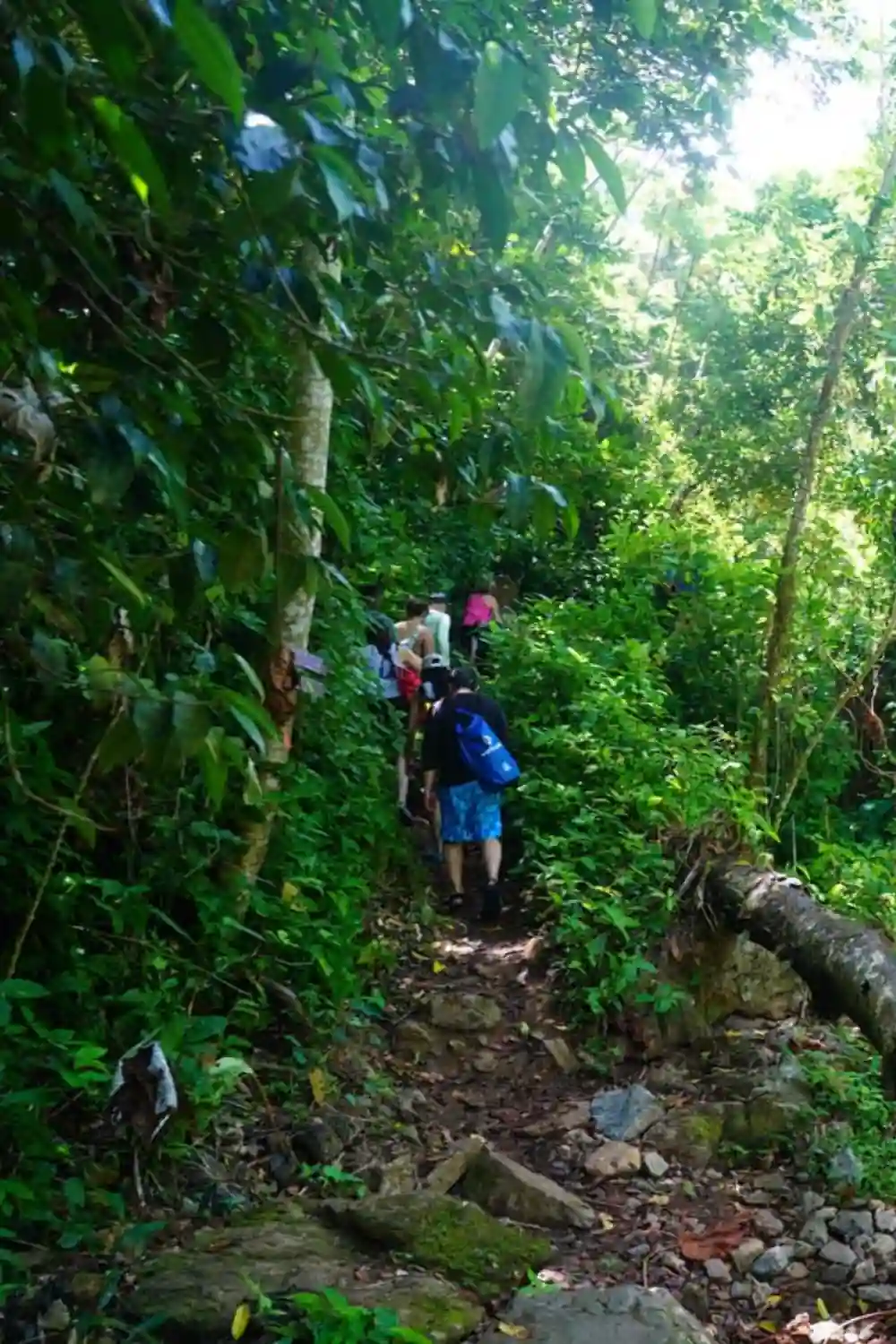
✔️ El Yunque National Forest (Mt Britton & El Yunque Peak)
The only tropical rainforest in the U.S. system, El Yunque National Forest is sacred ground for locals. I hiked up the Mt Britton Tower trail early in the morning, when mist still wrapped the canopy.
From the tower, the views stretch endlessly, and on clear days you can glimpse the Atlantic and the Caribbean Sea together. A side route to El Yunque Peak takes you deeper into cloud forest terrain, alive with unique bird species.
Puerto Rican friends often reminded me that El Yunque is more than just trees—it’s a cultural treasure tied to Taíno traditions. If you plan to go, download the AllTrails app or carry a GPS receiver, since cloud cover can quickly obscure paths. And yes, expect sudden rain showers; the rainy season makes the forest feel alive but also slick underfoot.
✔️ Cerro de Punta
For a change of scenery, drive inland toward Jayuya and climb Cerro de Punta, Puerto Rico’s highest point. The path is shorter but steep, with switchbacks cutting through pines and shrubs.
At the summit, you see the island’s full topography—from coastal plains to rugged mountains. For me, it was the best reminder that hiking here isn’t confined to the rainforest alone.
8. Jamaica
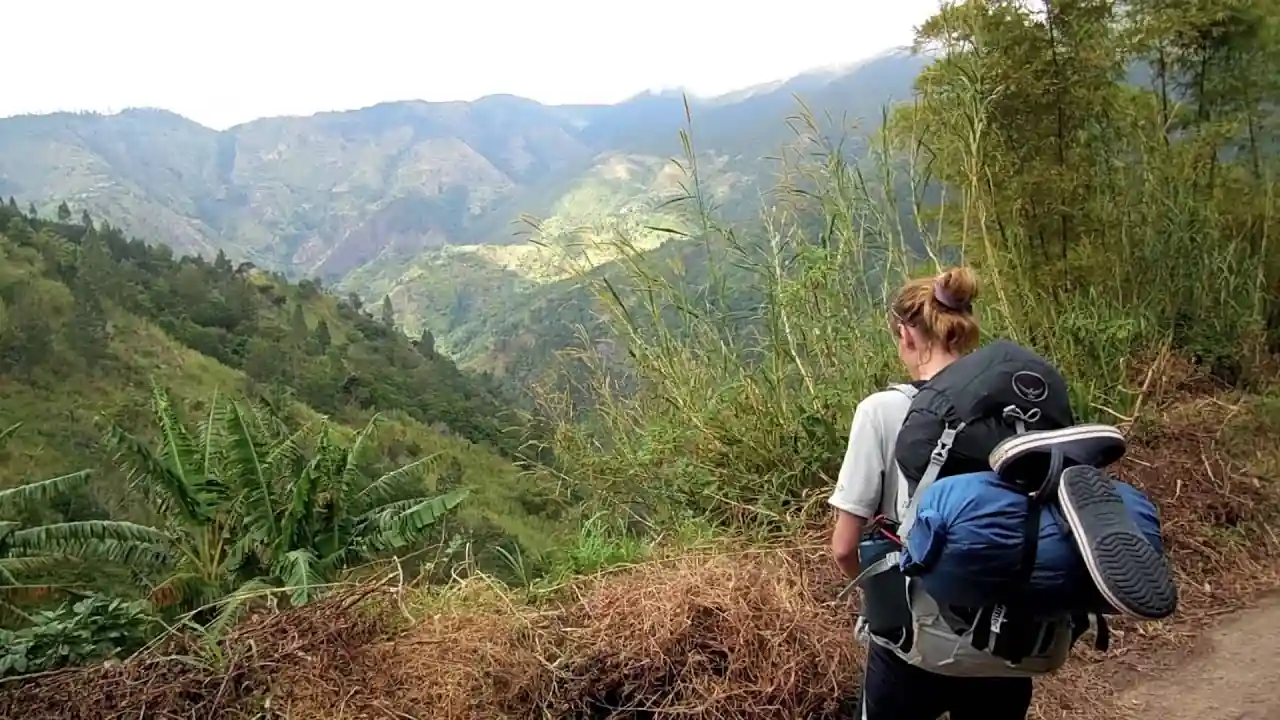
✔️ Blue Mountain Peak Trail
No Caribbean hiking list feels complete without Jamaica’s Blue Mountain Peak Trail. Locals swear by the pre-dawn start—you hike through the night, guided by flashlights and conversation, to catch the sunrise at 7,402 feet. I joined a group of coffee farmers who make this trek yearly, and their stories about working the slopes gave the mountain a new layer of meaning.
At the top, on a clear day, you might even see Cuba shimmering faintly on the horizon. The air feels crisp, almost alpine, and far removed from the reggae rhythms and beaches below. This contrast is what makes the Blue Mountains so unforgettable: they prove that Jamaica is much more than its coast.
9. Guadeloupe & Martinique
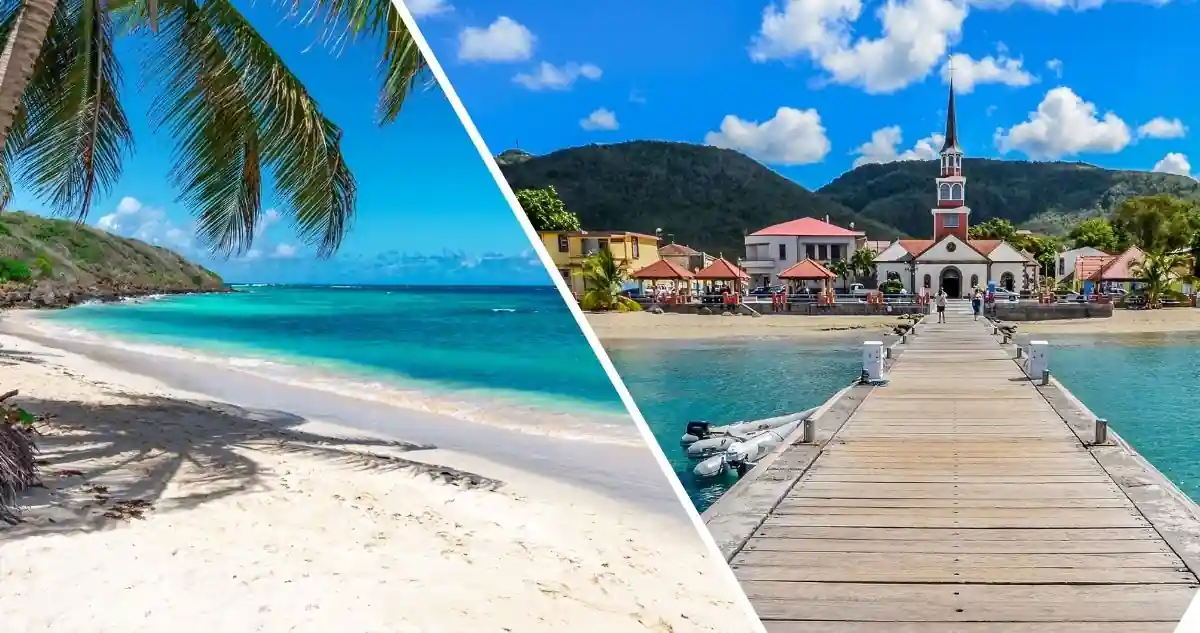
✔️ La Soufrière (Guadeloupe)
On the Guadeloupe Islands, La Soufrière dominates the skyline. Known as the “Old Lady,” this volcano rises over 4,800 feet and offers fumaroles, sulfur vents, and ridgelines that smell faintly of minerals.
Hiking from the L’Aileron Parking Lot along the N3 road, I felt the terrain shift from lush forest to barren volcanic rock. On misty days, the mountain disappears into clouds, making navigation tricky. The summit reminds you that these islands are alive, still reshaping themselves.
✔️ Mont Pelée (Martinique)
Equally legendary, Mont Pelée looms above Le Morne Rouge on Martinique’s northern coast. The Mount Pelee Trail starts gently but soon steepens, with switchbacks leading to panoramic views.
Locals never forget the 1902 eruption that destroyed Saint-Pierre, and many treat this climb as a lesson in resilience. When I reached the top, I watched clouds drifting across the crater, imagining the silence before history shifted so violently. Hiking here is more than scenery—it’s stepping into memory.
✔️ Gorges de la Falaise
Near Ajoupa-Bouillon, this hidden gem is less about summits and more about water. A short but slippery hike leads into a gorge carved by cascading streams. Guides help you wade through waist-deep water until you reach the falls. It’s adventurous, raw, and a reminder that Martinique’s beauty isn’t only volcanic—it’s aquatic too.
10. Aruba & Curaçao
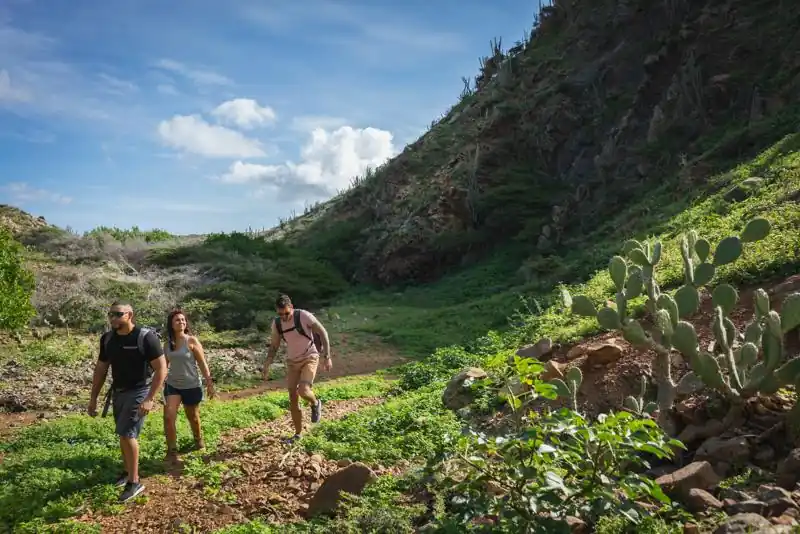
✔️ Arikok National Park (Aruba)
Aruba’s landscape feels nothing like Dominica’s rainforests. Arikok National Park is all desert scrub, cacti, and limestone caves. I took a trail that wound past coastal cliffs where waves smashed into the shoreline. It’s a stark, arid beauty—and the rangers here emphasize respecting delicate ecosystems that survive on minimal water.
✔️ Christoffel Mountain (Curaçao)
In Curaçao, Christoffel Mountain rises above cactus plains and goats grazing along the trail. The hike begins with dry heat, but as you ascend, breezes from the coast cool you down. From the summit, you see both the urban spread of Willemstad and the raw coastline.
The contrast is surreal: city colors on one side, endless blue horizon on the other. Locals recommend starting at sunrise to avoid the midday sun.
11. Cayman Islands
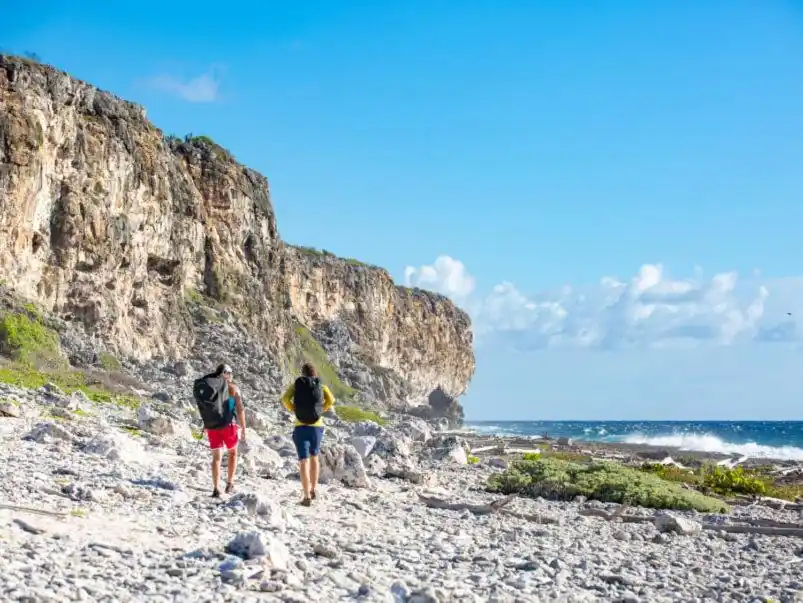
✔️ Mastic Trail (Grand Cayman)
One of the oldest paths on the island, the Mastic Trail takes you through preserved dry forest. It’s not about peaks but about biodiversity—you’ll spot rare plants and even iguanas if you’re lucky. The trail feels timeless, with sections paved by coral stones laid centuries ago.
What struck me most was how conservationists fought to keep this route intact. The National Conservation Bill protects areas like this, ensuring visitors see the island’s natural side beyond its resorts. Hiking here feels like stepping back into the Cayman Islands’ ecological history.
12. St John, U.S. Virgin Islands

✔️ Bordeaux Mountain Trail
Inside Virgin Islands National Park, the Bordeaux Mountain Trail offers the island’s highest vantage point.
The climb is steady but not punishing, starting near Waterlemon Cay and rising through dry forest. At the summit, the views stretch over Coral Bay and beyond to the outer cays.
I hiked this trail at sunset, and the colors spilling across the horizon felt like the island itself was glowing. Locals often hike it in cooler hours to avoid the midday heat.
✔️ Magens Bay Discovery Trail (St Thomas)
On nearby St Thomas, the Magens Bay Discovery Trail is short but rich in ecology. Interpretive signs highlight unique coral formations and native plants.
I remember spotting schoolchildren on a field trip, laughing as they learned about conservation from local rangers. It’s a gentle walk, but it ties together the island’s culture and environment beautifully.
✔️ Jack and Isaac Bay Preserve Trail (St Croix)
Less visited but deeply rewarding, this trail on St Croix winds along wild coastline to secluded beaches. Sea turtles nest here, and the area feels untouched compared to other islands. The combination of rugged hiking and calm shoreline made it one of my favorite quiet escapes in the U.S. Virgin Islands.
13. Dominican Republic
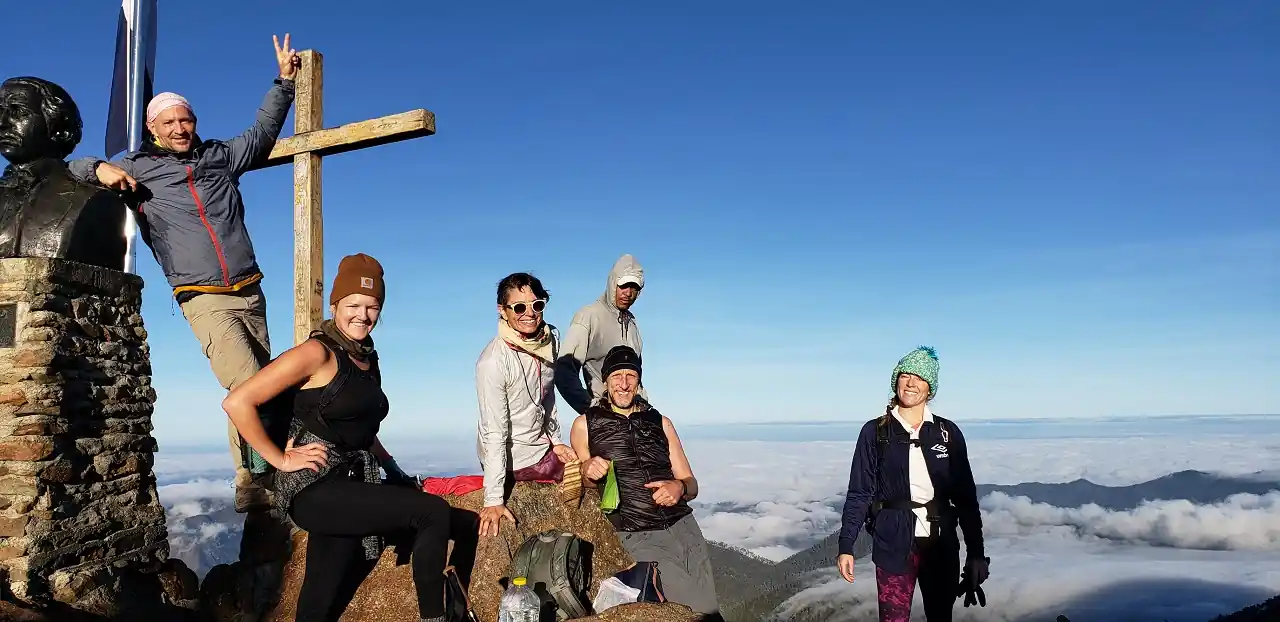
✔️ Pico Duarte
Climbing Pico Duarte is no small feat—it’s the Caribbean’s tallest peak at over 10,000 feet. The journey usually takes two to three days, with camping along the way. I joined a small group led by local guides, and we hiked through pine forests, rivers, and high-altitude grasslands.
Camping beneath the stars in the Cordillera Central felt worlds away from the resorts of Punta Cana. When dawn broke at the summit, the expanse of the Dominican Republic unfolded like a living map. It’s one of those hikes that demands effort but rewards you with perspective, both literally and figuratively.
14. Trinidad & Tobago
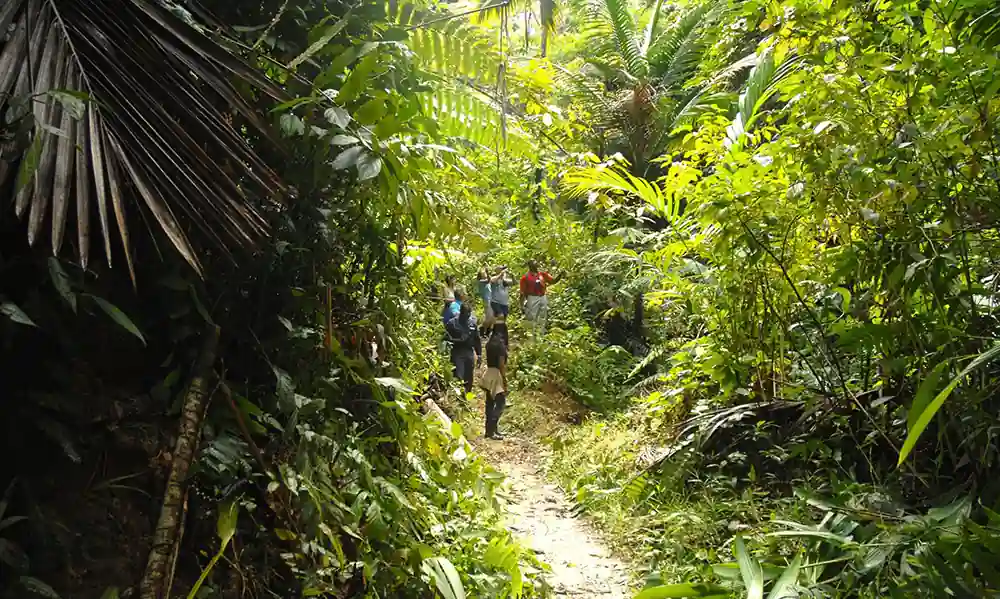
✔️ Tobago Main Ridge Forest Reserve
The oldest legally protected forest reserve in the Western Hemisphere, this trail is a gift for birdwatchers. I saw motmots, hummingbirds, and—thanks to my guide—the rare St Lucia parrot’s close cousin, a regional highlight for ornithologists.
The path itself winds beneath towering trees, always damp from ocean breezes. Locals emphasize its cultural importance; for them, this reserve isn’t just a forest, it’s heritage.
✔️ Paria Hike (Trinidad)
Trinidad’s Paria Hike is long but unforgettable, crossing headlands and rivers before reaching a remote waterfall spilling directly into the ocean at Saut d’Eau Bay. I trekked this route with university students who camped overnight at the beach.
It’s rugged, sometimes muddy, but worth it for the sense of discovery. Few hikes anywhere in the region end with a swim beneath a waterfall tumbling into the Caribbean itself.
Planning Your Caribbean Hiking Trip
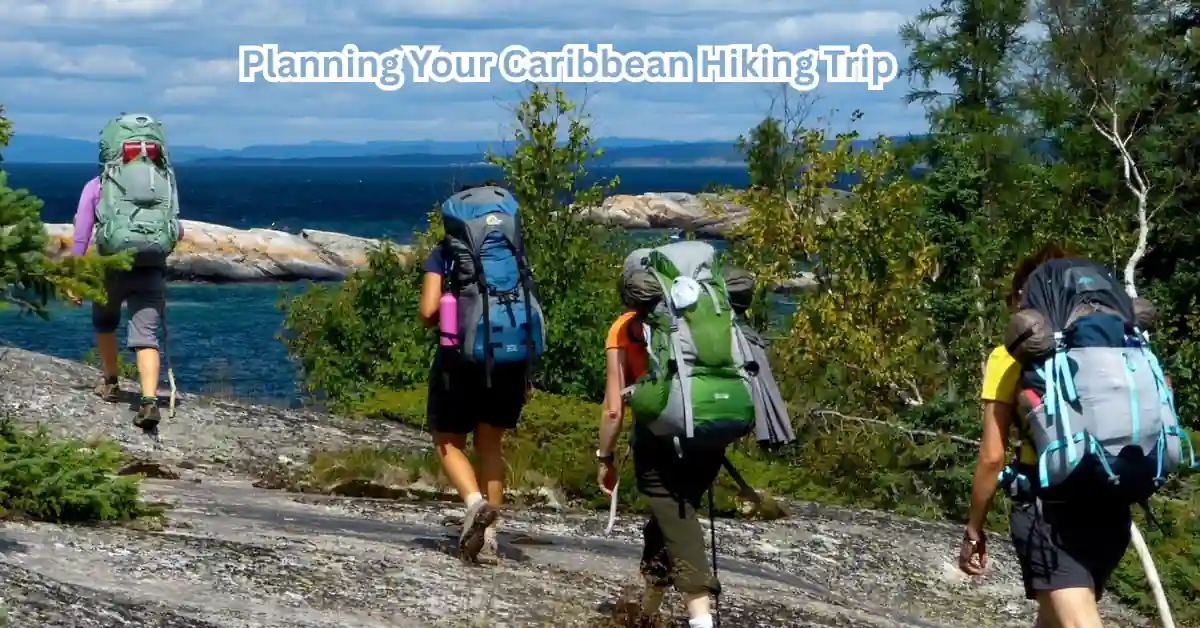
Choosing which island to visit depends on your hiking style. Do you want steep volcano climbs, rainforest treks, or gentler coastal walks? Locals often recommend pairing islands based on contrasting terrain.
Here’s a quick guide:
| Hiking Style | Best Islands | Example Trails | Insider Tip |
|---|---|---|---|
| Volcano Summits | Dominica, Martinique, St Vincent | Boiling Lake, Mount Pelee Trail, La Soufrière | Check the N3 road updates before tackling active peaks. |
| Rainforest & Waterfalls | Grenada, Puerto Rico, Trinidad | Seven Sisters Falls, El Yunque, Paria Hike | Download the AllTrails app or carry a GPS receiver for river crossings. |
| Short Scenic Trails | Saint Lucia, Saba | Tet Paul, Mount Scenery | Best for beginners, often guided by locals. |
| Long Distance Treks | Dominica, Dominican Republic | Waitukubuli Trail, Pico Duarte | Prepare for overnight camping areas and carry a reliable map. |
Budget planning is just as important. Here’s what to expect:
- Guides: $30–60 for half-day hikes (mandatory on Gros Piton and recommended on Boiling Lake).
- Transport: Shared taxis are affordable; private hires may be needed for remote trailheads.
- Park Fees: $5–15 in most national parks; special permits for multi-day hikes.
If you’re combining islands, look into ferry links in the Lesser Antilles. For example, you can hike Mount Scenery on Saba, then ferry to St Eustatius before flying to Saint Martin. Multi-island trips give you both variety and efficiency.
When to Go
Timing matters as much as location. Most trails are accessible year-round, but each season has trade-offs.
- Dry Season (December–April): Best weather, clearer skies, less mud. Crowds are higher, especially during Cruise Season.
- Rainy Season (May–November): Lush forests and full waterfalls, but trails are slippery. Pack extra rain gear.
- Hurricane Season (August–October): Riskier. Always check local advisories and have a backup plan.
Morning hikes are generally cooler and safer. On my climb of Mont Pelée above Le Morne Rouge, starting at 6 a.m. meant crisp air and fewer hikers. By noon, clouds had rolled in, obscuring the view.
Sunrise hikes—like the Blue Mountain Peak Trail or Pico Duarte—are unforgettable. Afternoons tend to bring storms, so plan accordingly.
What to Pack for Tropical Trails
Packing light but smart makes or breaks a Caribbean hike. Here’s a core list based on years of trial (and plenty of errors):
- Footwear: Lightweight, waterproof boots or trail shoes.
- Clothing: Quick-dry layers, long sleeves for mosquito-heavy zones.
- Rain Gear: Compact poncho or jacket—showers hit fast.
- Hydration: 2L water bladder plus electrolytes.
- Navigation: GPS receiver (2nd mention ✅) or reliable map backup.
- Protection: Insect repellent, sunscreen, wide-brim hat.
- Safety: Small first-aid kit, headlamp, whistle.
- Extras: Dry bag for electronics, camera for volcanic landscapes.
When I hiked La Soufrière from the L’Aileron Parking Lot, I underestimated how slippery the trail would be after rain. Having trekking poles would’ve saved me from more than one tumble. Little details in your pack make the difference between frustration and flow.
Mini-Itineraries Suggested by Locals
Sometimes the best way to experience the Caribbean is through short, focused trips where hiking anchors your days. Locals often suggest balancing adventure with culture, food, and downtime at the beach.
Weekend in Dominica
Start with the Boiling Lake trek in Morne Trois Pitons National Park, then spend a quieter second day tackling Morne Diablotins, the island’s highest peak. It’s less crowded but equally rewarding, with views that sweep across Dominica’s rugged ridgelines. End the trip with a soak at Sulphur Springs, a natural hot bath that local guides swear helps after long hikes.
Short Break in St Lucia
Dedicate one day to the Gros Piton Hike, then balance it with the gentler Tet Paul Nature Trail. If you’re staying near the south, add a detour to the Edmund Forest Reserve, where shaded trekking trails reveal medicinal plants still used in local remedies. On your final morning, drive to Cap Chevalier and Diamant Bay—where the famous Diamond Rock rises like a fortress from the sea. Locals say sunrise here is unforgettable.
Hiking Combo in St Kitts & Nevis
Pair Mount Liamuiga with the steep Nevis Peak. If your visit aligns with the Nevis Marathon and Running Festival, you’ll see how islanders celebrate endurance beyond the trails. Staying longer? Locals often recommend crossing to St Maarten for nightlife before looping back.
Quick Saba Adventure
Spend a day on the iconic Mount Scenery climb, then wander into the charming villages. For a half-day, try coastal paths near the old harbor, where you’ll find dramatic views over the sea. Many hikers pair this with a stop in St Eustatius or ferrying to Saint Martin—classic examples of Active Caribbean Travel.
Responsible Hiking & Cultural Respect
The Caribbean’s trails pass through fragile ecosystems and deep cultural heritage sites. Locals emphasize respect, not just for the land but for the communities who protect it.
- Stay on trails: Some routes, like the Cascade de la Riviere Couleuvre Trail in Martinique, cut through delicate rainforest. Straying off path damages rare plants.
- Leave No Trace: Always pack out waste, especially on remote treks like Morne Piquet or the Canal des Esclaves, both steeped in colonial history.
- Support locals: Hiring guides keeps cultural knowledge alive. In Grenada, a guide showed me the Devil’s Tooth rock formation, a spot I’d never have found on my own.
- Respect sacred places: Trails like those near Saut d’Eau Bay in Trinidad carry spiritual meaning for locals—treat them with care.
Responsible hiking means blending curiosity with humility, always remembering you’re a guest on these trails.
Final Thoughts
After years of exploring, I’ve come to believe the best places to hike in the Caribbean aren’t just trails—they’re lessons in resilience, culture, and nature’s raw power. From Dominica’s boiling volcanic lakes to Jamaica’s sunrise climbs, every path shows a side of the islands that beaches can’t.
One of my most memorable mornings was in Martinique, walking coastal paths near Cap Chevalier before heading inland to the La Caravelle Nature Reserve. The contrast between rugged cliffs, bird calls, and swaying mangroves was a reminder that the Caribbean’s beauty lies in its diversity. Add in moments like seeing Cap Chevalier at dawn or hiking through fumaroles on La Soufrière, and you understand why locals hold these places sacred.
For travelers, the lesson is clear: the Caribbean is not just about resorts or cocktails by the shore. It’s about rainforests that heal, ridgelines that test your lungs, and stories shared by guides who’ve known these trails their whole lives.
Pair the famous hikes with hidden gems, respect the land and communities, and you’ll leave with something richer than photos—you’ll carry the rhythm of the islands themselves.
So plan carefully, hike responsibly, and don’t just look for beaches. Lace up your boots, follow the locals’ lead, and step into landscapes that feel timeless. These islands are alive, and every hike is an invitation to be part of their story.
Frequently Asked Questions
Q.1: What’s the easiest hike for beginners?
A: The Tet Paul Nature Trail in Saint Lucia and the Magens Bay Discovery Trail in St Thomas are short, scenic, and perfect for new hikers.
Q.2: Do I need a guide for Gros Piton or Boiling Lake?
A: Yes, guides are required for Gros Piton and strongly recommended for Boiling Lake. They not only ensure safety but also share cultural stories tied to the land.
Q.3: How much water should I carry?
A: At least 2 liters per person. On long hikes like Pico Duarte, guides often point out natural springs, but don’t rely on them without purification tablets.
Q.4: Are hikes safe during hurricane season?
A: Conditions vary. Check updates with local tourism offices. After storms, trails like Dunn’s River Falls in Jamaica and Mayfield Falls may close temporarily.
Q.5: What’s the best overall month to hike?
A: March offers a sweet spot—drier weather and fewer crowds. It’s also festival season in some islands, making it ideal for combining hiking with culture.
Q.6: Any must-see beyond the hikes?
A: Absolutely—Crane Beach in Barbados, Sandy Island in Carriacou, and snorkeling at Shark Ray Alley in Belize all complement the trekking experience.
Q.7: What’s unique about Caribbean hiking compared to elsewhere?
A: Few places combine beaches, volcanoes, and cultural depth. While I once climbed Mount Batur in Bali, the Caribbean’s mix of ecology and history feels unmatched.
Q.8: Are local governments active in conservation?
A: Yes. The Cayman Islands Legislative Assembly and initiatives like the National Conservation Bill show ongoing efforts. On the political side, leaders such as Jamaica Prime Minister Portia Simpson Miller, Trinidad Foreign Minister Winston Dookeran, and even Haiti President Michel Martelly have tied conservation to wider development goals discussed with the Commonwealth Finance Ministers.
Q.9: Can I combine hiking with running events?
A: Definitely. Runners love the Reggae Marathon in Jamaica and the Marathon Bahamas, which often overlap with hiking seasons. Both showcase the blend of endurance sports and Caribbean culture.
Q.10: Is the Caribbean welcoming to eco-conscious travelers?
A: More than ever. Local initiatives, from small community guides to broader projects by Jamaican investors, are reshaping the narrative. Many tours highlight how hiking and conservation fuel Active Caribbean Travel.
Recent Posts
 Tubeseferi: 7 Must-Know Features for Smart City Travel in 2025
Tubeseferi: 7 Must-Know Features for Smart City Travel in 2025 What Is Antolohe? Hidden Travel Meaning Revealed for 2025
What Is Antolohe? Hidden Travel Meaning Revealed for 2025 How to Become a Travel Agent Without Experience?
How to Become a Travel Agent Without Experience? 15 Best Airlines for Long Flights in 2025: Comfort, Cuisine, and Sky-High Service
15 Best Airlines for Long Flights in 2025: Comfort, Cuisine, and Sky-High Service Day Trips from Buenos Aires: Surprising Routes Off the Tourist Trail
Day Trips from Buenos Aires: Surprising Routes Off the Tourist Trail
